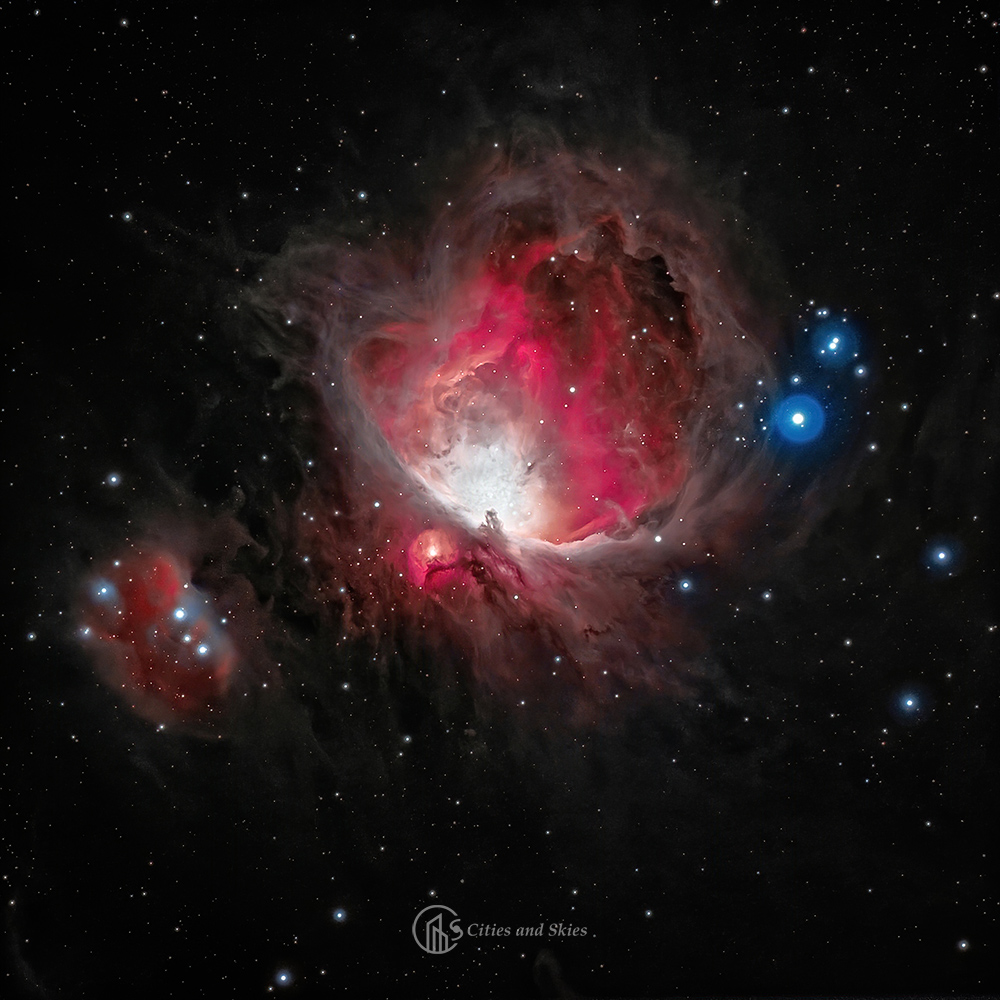The Orion Nebula can be found to the south of Orion’s Belt, in the constellation Orion. It is a diffuse nebula in the Milky Way, that harbors lots of young stars. Stars frequently form in groups, called open clusters. The most ideal conditions for star formation are in cold, dusty places, deeply hidden in vast molecular clouds. As young stars are feeding on hydrogen they are getting hotter, and they illuminate their surroundings. There are two ways this can happen. Dust in these clouds will scatter the starlight, creating a reflection nebula like the one around the stars of Pleiades. Or they excite hydrogen atoms and make them glow, like the Rosette Nebula. Most stars in open clusters remain close to their birthplaces for tens, or even hundreds of million years, till they scatter in a few Galactic rotations.
Unrest at the nursery
But not the stars in the Orion Nebula! This galactic stellar nursery is a very dynamic place, with stars having higher-than-usual velocities compared to what we would expect. This may be due to 3-body interactions between very massive stars. Simulations even predict that some stars might be driven towards the central core of the cluster, where eventually they may form a massive black hole. In our humble opinion, if this was true, we would have already detected this black hole at high energies, as it was feeding on the gas within the nebula. But true enough, cataclysmic events or stellar interactions may cause some stars to run away from their birthplaces, at unusually high speeds. And this is exactly what happened to the Flaming Star, which had its birthplace in the Orion Nebula, but which is located constellations away today.
This is a very young stellar nursery that is also the closest to Earth, providing an excellent opportunity to study massive star formation. The gases within the nebula are extremely turbulent due to massive stellar winds from the four youngest and most massive stars in the center, the Trapezium. Several smaller stars around the core show proto-planetary disks, or “proplyds“, where eventually planetary systems may form. However, these proplyd systems could not have been formed under the tremendous radiation pressure from the Trapezium stars, unless those came to light much later. Some of these could be just 10.000 years old compared to the few million years for the rest of the cluster. In this case, our stone-age ancestors may have not seen this nebula shine this bright in the skies!
Shooting details of the Orion Nebula
For all of our projects so far, this turned out to be the most challenging – even though this is a really bright and wonderful target. Orion appears just above the street lights and there is only a short time we can make useful images. We practiced with both our broad-band light pollution filter (Optolong L-Pro), to bring out the reflection parts better (e.g. in the nearby Running Man nebula, to the left), and the narrow-band filter (L-eXtreme) that produced the sharpest views of the filaments in the nebula. In the end, we just used the latter, because in the cold winter nights (going down to minus 10 degrees Celsius) our focus changed quickly and the L-Pro images became somewhat blurry.
The best opportunities we had on the nights of 12-13 and 13-14 February 2021. It is exceptionally rare to have a crystal clear view of the Skies and New Moon at the same time! The long winter nights also provided a great opportunity to turn our telescope to quite different targets: galaxies. To be continued…
Further read for astronomers: “Catch me if you can!“.
Technical data
Orion (Messier 42, 43) and the Running Man nebulae, 4.8h
Combination of two shots taken with a different camera gains
Hoogeveen, Netherlands
13-14 Jan. 2021, 36 frames (selected from 60x180s shots) with gain 101, central parts better preserved; intermittent clouds
13-14 Feb. 2021, 60x180s frames with gain 240 on a Moonless, clear night!
William Optics GT81, f/5.9
Flattener 6AIII 0.8x
ZWO ASI533MC-P, gain 101/240, -20 deg.
WO Uniguide 50/200 with ASI120MMmini
iOptron CEM40
Optolong L-eXtreme
ASIair
Bortle~5 (our region; in the town, it should be worse)
New Moon
Astro Pixel Processor (trial version), Photoshop
Stacked in Astro Pixel Processor in 32-bit mode, which gives more color. Then moved to 16-bit mode and done rest in Photoshop (stretching/curves/noise reduction and combining the two images[shift+rotate]). Green halo removed around brightest stars.
